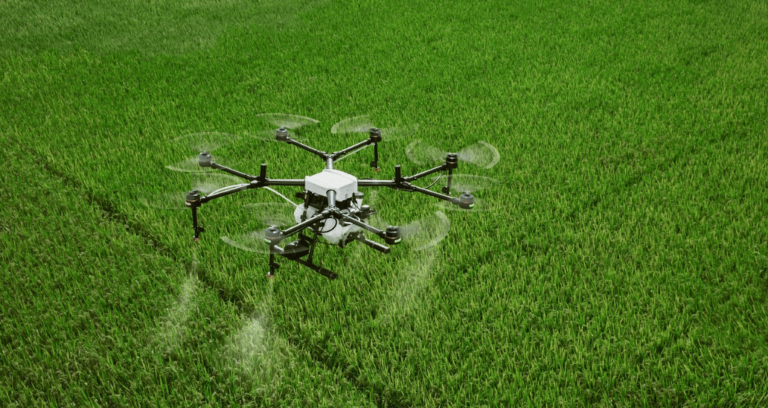
Agriculture is one of the most important sectors of the Indian economy, contributing about 16% of the GDP and employing nearly 42% of the workforce. However, the sector faces many challenges such as low productivity, climate change, pest infestation, water scarcity, and lack of mechanization. To overcome these challenges, farmers must adopt innovative technologies that enhance their efficiency, profitability, and sustainability. One such technology is drone or unmanned aerial vehicle (UAV), which has the potential to revolutionize various aspects of agriculture.
Find Your Drone Best Drone Seller In India
What are drones and how do they work?
Drones are remotely piloted aircraft that can fly autonomously or with human intervention. They can carry various sensors and payloads such as cameras, GPS, LiDAR, multispectral and hyperspectral imagers, sprayers, and seeders. Drones can perform various tasks such as:
- Crop and soil health monitoring: Drones can capture high-resolution images and data of the crops and soil at different wavelengths, which can be processed and analyzed to detect diseases, pests, weeds, nutrient deficiencies, moisture levels, and crop growth stages. This can help farmers to take timely and precise actions such as irrigation, fertilization, pest control, and harvesting.
- Crop spraying: Drones can spray pesticides, herbicides, and fertilizers on crops with high accuracy and efficiency, reducing wastage, cost, and environmental impact. Drones can also spray hard-to-reach areas such as hills, terraces, and orchards.
- Crop seeding: Drones can sow seeds on the fields with uniformity and speed, reducing labor requirements and improving germination rate. Drones can also sow seeds in difficult terrains such as wetlands, deserts, and mountains.
- Crop assessment: Drones can measure various parameters of the crops such as yield, quality, biomass, height, and density. This can help farmers estimate their production and income and claim insurance in case of crop damage or loss.
- Digitization of land records: Drones can map land parcels and boundaries with high accuracy and resolution, which can be used to create digital land records. This can help farmers secure their land rights, access credit and subsidies, resolve disputes, and plan their cropping patterns.
What are the benefits of drones for agriculture?
Drones offer many benefits for agriculture such as:
- Increased productivity: Drones can help farmers to optimize their inputs and outputs, resulting in higher crop yield and quality.
- Reduced cost: Drones can reduce the cost of labor, fuel, machinery, and chemicals, as well as the risk of crop failure.
- Enhanced sustainability: Drones can reduce the environmental impact of agriculture by minimizing water consumption, soil erosion, greenhouse gas emissions, and chemical pollution.
- Improved decision-making: Drones can provide real-time data and insights to farmers, enabling them to make informed decisions based on scientific evidence.
- Empowered farmers: Drones can increase the access and affordability of agricultural services to smallholder farmers, especially in remote and marginal areas. Drones can also create new employment opportunities for rural youth.
The government of India has recognized the potential of drone technology for agriculture and has taken several steps to promote its adoption and innovation. Some of the major schemes and initiatives are:
Kisan Drones: This is a flagship initiative launched by Prime Minister Narendra Modi on 19 February 2022 to provide drone services to farmers across the country. The scheme is implemented by Garuda Aerospace, a start-up company that has developed indigenously designed and manufactured drones for agriculture. The scheme aims to cover 10 lakh hectares of farmland in the next three years and provide services such as crop health monitoring, pest control, fertilizer application, etc. The scheme also involves training and skilling of rural youth as drone pilots and technicians.
Sub-Mission on Agricultural Mechanization (SMAM): This is a scheme under the Ministry of Agriculture and Farmers Welfare that provides financial assistance to various stakeholders for the purchase and use of agricultural machinery and equipment, including drones. The scheme has been amended in January 2022 to provide up to 100% subsidy or Rs. 10 lakhs, whichever is less, to the Farm Machinery Training and Testing Institutes, ICAR Institutes, Krishi Vigyan Kendras, and State Agriculture Universities for buying drones for demonstration purposes. The scheme also provides up to 75% subsidy or Rs. 4 lakhs, whichever is less, to the Farmers Producers Organizations (FPOs), Cooperative Societies of Farmers, and Rural Entrepreneurs for setting up Custom Hiring Centers (CHCs) or Hi-tech Hubs that can offer drone services to farmers. The scheme also provides a contingency expenditure of Rs. 3000-6000 per hectare for drone demonstrations.
SENSAGRI: This is a collaborative research project initiated by the Indian Council of Agricultural Research (ICAR) through the Indian Agricultural Research Institute (IARI) in 2016. The project involves six partner institutes from agriculture and IT domains and is funded by the Information Technology Research Academy (ITRA), Department of Electronics and Information Technology (DEITY), Ministry of Communication and Information Technology (MCIT), Government of India and ICAR. The project aims to develop an indigenous prototype for a drone-based crop and soil health monitoring system using hyperspectral remote sensing (HRS) sensors. The project also aims to integrate drone technology with satellite-based technologies for large-scale applications. These are some of the prominent schemes and initiatives taken by the government of India to promote the use of drones in agriculture. These schemes reflect the government’s vision to make agriculture more profitable, modern, and sustainable by leveraging innovative technology.
Scouting/Monitoring Plant Health
One of the uses for drone imagery that has already been rolled out with great success is for monitoring plant health. Drones equipped with special imaging equipment called Normalized Difference Vegetation Index (NDVI) use detailed color information to indicate plant health. This allows farmers to monitor crops as they grow so any problems can be dealt with fast enough to save the plants. This image illustrates simply how NDVI works.
Drones using ‘regular’ cameras are also used to monitor crop health. Many farmers already use satellite imagery to monitor crop growth, density, and coloration, but accessing satellite data is costly and not as effective in many cases as closer drone imaging. Because drones fly close to fields, cloud cover, and poor light conditions matter less than when using satellite imaging. Satellite imaging may offer meter accuracy, but drone imaging is capable of producing accurate image location to the millimeter. This means that after planting, areas that withstand gaps can be spotted and replanted as needed, and disease or pest problems can be detected and treated right away.
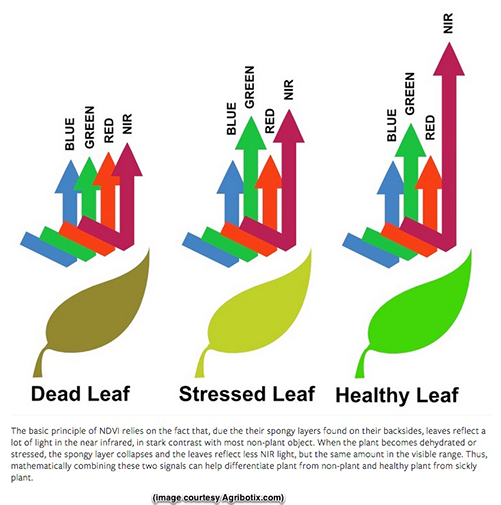
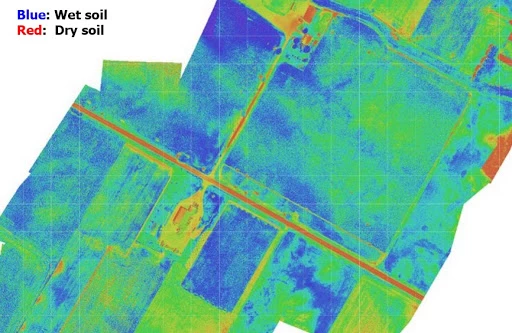
Monitoring Field Conditions
Drone field monitoring is also being used to monitor the health of soil and field conditions. Drones can provide accurate field mapping including elevation information that allows growers to find any irregularities in the field. Having information on field elevation is useful in determining drainage patterns and wet/dry spots which allow for more efficient watering techniques. Some agricultural drone retailers and service providers also offer nitrogen level monitoring in soil using enhanced sensors. This allows for precise application of fertilizers, eliminating poor growing spots and improving soil health for years to come.
Planting & Seeding
One of the newer and less widespread uses of drones in agriculture is for planting seeds. Automated drone seeders are mostly being used in forestry industries right now, but the potential for more widespread use is on the horizon. Planting with drones means very hard-to-reach areas can be replanted without endangering workers. They are also able to plant much more efficiently with a team of two operators and ten drones capable of planting 400,000 trees a day.

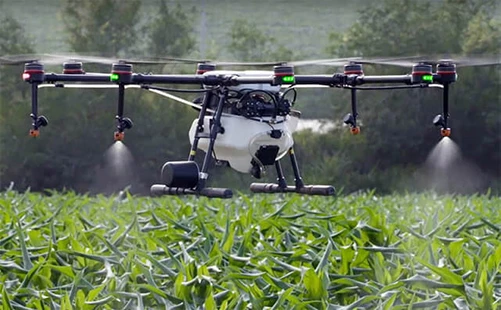
Spray Application
Drone use to apply spray treatments is already widespread in Southeast Asia, with South Korea using drones for approximately 30% of their agriculture spraying. Drone sprayers can navigate very hard-to-reach areas, such as steep tea fields at high elevations. Drone sprayers save workers from having to navigate fields with backpack sprayers, which can be hazardous to their health. Drone sprayers deliver very fine spray applications that can be targeted to specific areas to maximize efficiency and save on chemical costs. Currently, drone sprayer regulations vary widely between countries. In Canada, they are not currently legal as more testing needs to be done to understand the impact of spray drift. Some regulation proposals recommend that only trained professionals be tasked with flying spray drones as is the case with Yamaha, which does not sell the spray drones they manufacture, but leases spray drone services complete with licensed operators.
Security
Drone security is a fast-growing industry apart from agriculture but is also extremely useful to farm management. Using drones to monitor the far reaches of a farm without having to get there saves valuable time and allows for more frequent monitoring of hard-to-reach areas. Drone cameras can provide an overview of farm operations throughout the day to ensure operations are running smoothly and to locate equipment being used. Security drones can be deployed to monitor fencing and perimeters of more valuable crops like cannabis instead of employing more security personnel. Drone cameras are also being used in exciting ways to protect farm animals by locating missing or injured herd animals in far-off grazing areas. Monitoring remote areas, which used to take hours of walking can now be completed in a few minutes.
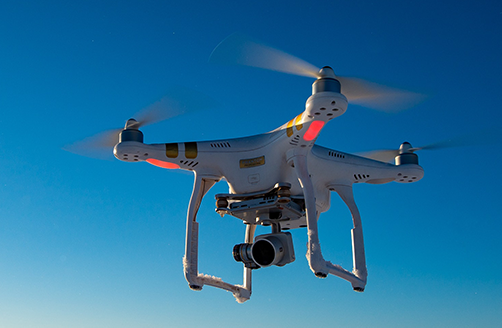
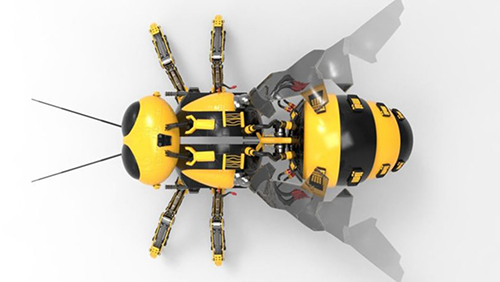
Drone Pollination
Some of the newer uses for drone use in agriculture are still in testing and development. One of the most publicized (and often fictionalized) uses is pollinating drone technology. Researchers in the Netherlands and Japan are developing small drones that are capable of pollinating plants without damaging them. The next step is to create autonomous pollinating drones that will work and monitor crop health without constant instruction from operators.
Drone AI
Another drone technology in development also involves machine learning. Improving Artificial Intelligence (AI) in drones is important to be able to make them more useful to smaller farmers in developing nations. Current drone technologies are more effective in monitoring well-known crops like corn which are planted in large monocultural field patterns. Drone monitoring programs, as they stand, have a hard time recognizing areas with increased crop diversity, less well-known produce, and grains that look similar throughout their growth stages and so are less effective in monitoring crop growth and health. More work is needed to be able to train AI systems to recognize less common crops and more diverse planting patterns.

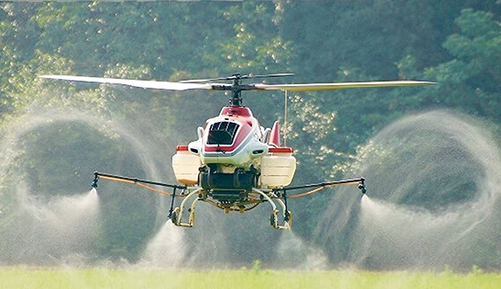
Drone Irrigation
New research out of Australia is also creating exciting opportunities for drone use in agriculture. As climate change increasingly affects drought conditions, creating more efficient irrigation solutions is vital. Using microwave sensing, drones can capture very accurate soil health information including moisture levels without the plants getting in the way. This means water can be distributed in a field most efficiently to conserve resources.